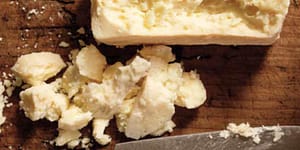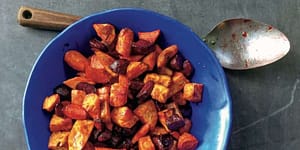Make Your Own Apple Kimchi

Kimchi is a tangy and spicy meal with many varieties, including some with fruits. This recipe for apple kimchi adds a seasonal twist to a classic Korean dish!
The following is an excerpt from Black Trumpet by Evan Mallett. It has been adapted for the web.
RECIPE: Apple Kimchi
Denise gave me a 5-gallon ceramic “rot pot” for my birthday one year. I made my favorite crock pickle recipe from our garden’s bounty of heirloom cukes. Then came more complex ferments. Soon, I came to realize that fermentation is not as scary as it seems.
I went through a two-year phase of fermentations for home before I came up with one I liked enough to try at the restaurant. Our staff went nuts for Apple Kimchi. It was like cuckoo for Cocoa Puffs, but with a really healthy result.
Makes about 4 glass 1-quart (1 L) jars
 Ingredients
Ingredients
- 1 head napa cabbage, outermost leaves removed, quartered lengthwise, core removed, and chopped crosswise in 1/4-inch (0.5 cm) ribbons
- 1 head red cabbage, outermost leaves removed, quartered lengthwise, core removed, and chopped crosswise in 1/4-inch (0.5 cm) ribbons
- 1 large Spanish onion, julienned
- 1 large carrot, grated
- 8 ounces assorted fresh chiles, rough-chopped, with seeds intact
- 1 head garlic, cloves peeled and thinly sliced
- 1 thumb gingerroot, peeled and sliced (1 1/2 tablespoons)
- 12 cups (2.8 L) water
- 1 cup (235 ml) cider vinegar
- 6 apples, preferably a dense heirloom variety like Blue or Gray
- Pearmain
- 1 1/4 cups (185 g) salt
- 1/3 cup (80 ml) maple syrup
- 1 stalk Mexican mint marigold (can substitute tarragon or fennel frond)
Procedure
- Mix the first seven ingredients in a large bowl, then pack in a 5-gallon (20 L) ceramic fermenting jug.
- On the stove, bring the six remaining ingredients to a boil, stir to ensure that the salt is fully dissolved, let cool, and pour into the fermenter, placing a plate or weight on top to fully submerge the veggies. Don’t worry if, at first, the vegetables are not fully submerged. They will be after a few hours of being pressed. In 3 days, the fermentation process will be under way.
- Remove the weight and inspect the top for any signs of mold. If there is mold forming, remove the surface vegetables that are hosting the mold and then—with clean tongs—stir the contents of the pot, replacing the weight and letting the ferment sit for another 3 days.
- Repeat the inspection process and let sit for 4 more days. After this 10-day period, the ferment should be sour, lightly effervescent, and full of intense flavor.
- At this point, you can choose to let it go longer for more intense flavor or pack the kimchi into sterilized quart jars, filling up each jar to the very top with the fermenting liquid, then tightly lidding the jars before refrigerating. I have kept ferments of this nature in my refrigerator for over a year, but you may want to err on the side of caution and consume it over a shorter time frame.
Recommended Reads
Recent Articles
If you read our post about growing koji in your kitchen, you’re probably itching to try out those new koji skills! This miso cheese recipe is an excellent next stop on your koji-kitchen journey. Miso cheese is sure to add a twist to any cheese lover’s plate, plus it’s easy to make at home! The following…
Read MoreDo you still have an abundance of root veggies from your final fall harvest? You’re in luck! This pomegranate drizzle will add just the right amount of “oomph” to your favorite dish of roasted root veggies. The following recipe is from The Fruit Forager’s Companion by Sara Bir. It has been adapted for the web. RECIPE:…
Read MoreGrains are a ubiquitous part of the American diet and a staple in many of our favorite recipes. Bread? Yep, grains. Pasta? Grains there, too. Pancakes? Most definitely! With such a strong presence in our daily eating habits, shouldn’t we know more about what grains actually are and why they make our favorite foods taste…
Read MoreTurn any night into pizza night! This sourdough pizza holds the secret to a stress-free weeknight dinner. Make the crust ahead of time and let it rise in the fridge. By dinnertime all you’ll need to do is shape the dough, add your toppings, and bake! This excerpt is from The Occidental Arts and Ecology…
Read MoreA sweet cornbread made with blue cornmeal draws on traditional Mexico and US Southwest flavors. The blue cornmeal gives its haunting flavor and lavender hue.
Read More









